

| Name | Description | Object ID | |
|---|---|---|---|
 |
Ema |
This is a small wooden ema, or votive plaque, that is painted with a design of a cow sitting on grass below a gold cloud. There are several inscriptions with Japanese characters and a red stamp at the bottom left. A blue cord tied through small hole drilled at top would allow the buyer... |
2006.X.68 |
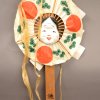 |
Post |
This ceremonial post was used for the beam raising of The Japanese House at the Boston Children's Museum. The post is made of cedar with Japanese text translated as "Kyo no Machiya Beam Raising Ceremony; Hosted by Kyoto and Boston"; date: "Auspicious Day, Showa 54 [1979], July 25." The text also... |
2012.5.2 |
|
|
Torii |
This small torii, or Shinto gate, is painted the traditional vermilion red. The top is slightly curved and is painted black. Each leg of the pole structure is connected to a square-shaped base, also made of wood and painted black. In the Shinto religion, which is indigenous to... |
AB 298 |
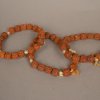 |
Juzu Prayer Beads |
This set of three Buddhist prayer or rosary beads (called "juzu" in Japanese) features beads of both glass and seeds. Each strand has three clear glass beads. One strand (AB 55-24 a) has a total of 19 seed beads, while AB 55-24 b has 17 and AB 55-24 c has 18. On each strand, the glass... |
AB 55-24 a-c |
 |
Shinto Amulets |
This pair of small carved wooden Shinto amulets or charms is intended to ward off evil. The amulets are each shaped like a round human face with hair and other features carved in, and are attached to blue cords. There are Japanese characters in green and red on the backs of the amulets. The... |
AB 76-115 and AB 76-116 |
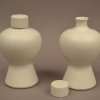 |
Wine Jar |
These two ceremonial sake jars are a pair. Both are white, unglazed porcelain, with a flared base, an urn-shaped body, and a narrow mouth with a cylindrical lid. This ceremonial stoneware was used for the opening ceremony, Shunko-shiki, of The Japanese House on October 14,... |
AB 79-2 a,b |
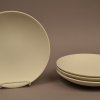 |
Offering Plate |
This is a set of four unglazed, ceremonial porcelain plates. They would have been used to hold fruit, lobster, rice, and salt as offerings to honor the land, sea, and mountains. This ceremonial stoneware was used for the opening ceremony, Shunko-shiki, of The Japanese House on... |
AB 79-2 c d e f |
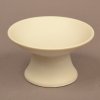 |
Offering Plate |
This white, unglazed porcelain ceremonial dish with a pedestal was used during the opening ceremony, Shunko-shiki, of The Japanese House on October 14, 1979. |
AB 79-2 q |
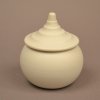 |
Ceremonial Bowl |
This white, unglazed porcelain bowl with a lid was used for ceremonial purposes during the opening ceremony, Shunko-shiki, of The Japanese House on October 14, 1979. |
AB 79-2 r |
 |
Ceremonial Tray |
This bentwood tray was one of four used during the opening ceremony, or Shunko-shiki, of The Japanese House in 1979. |
AB 79-3 a |
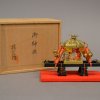 |
Miniature Omikoshi |
This miniature omikoshi, or portable Shinto shrine, comes with a wooden box and rests on a red fabric-covered platform. The bottom half of the omikoshi is black wood with two long beams tipped with gold, with gold handles on each end. Long beams are supported by two planks at... |
AB 81-130 |
|
|
Kamidana |
This kamidana, or Shinto shrine, consists of three pieces: (a) the shrine itself, (b) the door piece, and (c) a plaque. It was originally in kitchen of The Japanese House. The kamidana is a small, wooden structure with two front doors that open out. Inside the shrine, there... |
AB 81-19 a-c |
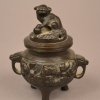 |
Incense Burner |
This blackened bronze kōro, or incense burner, features the komainu ("lion dog") on its lid. The komainu, also known as the shishi or jishi, is a creature typically seen at the gates of Shinto shrines and Buddhist temples. Komainu are... |
AB 81-2 d |
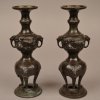 |
Candlesticks |
This set of two candlesticks is meant to go in a butsudan, or household Buddhist altar. Made of blackend bronze, the candlesticks have a narrow neck with a wide flute mouth. They have a figure eight shape below with two handles, with three legs on a round base, and bas relief... |
AB 81-2 e,f |
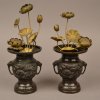 |
Altar Vases |
These blackened bronze vases with brass lotus blossoms were made to be part of a butsudan household altar. The vases have wide mouths, constricted necks, two handles, and a bas relief design. The several lotus blossoms are on individual stems that are soldered together and stick out... |
AB 81-2 g, h |
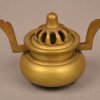 |
Ceremonial Bowl |
This small, smooth brass incense burner, called a kōro, was made to be part of a butsudan household altar. The pot features two winged handles and has a lid with a nob and several openings to let the smoke from the incense escape. A butsudan (literally "... |
AB 81-2 kk |
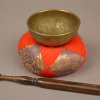 |
Altar Bell |
This brass bowl-shaped rin (bell) is meant to be part of a butsudan, or household Buddhist altar. The rin sits on a red cushion with purple and gold diamond-patterned decorations. The rin comes with a dark, wooden striker with a rounded head and a pinched... |
AB 81-2 n |
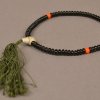 |
Prayer Beads |
This string of black Buddhist prayer beads, called juzu, are meant to be part of a butsudan household altar. The beads are likely made out of glass and the majority are black, but two red beads and the knot divide the strand into three sections. Tied at the knot is a green... |
AB 81-2 o |
|
|
Cloth, Altar |
This silk brocrade triangular cloth is meant to hang from a shelf in a butsudan, or household Buddhist altar. The altar cloth is embroidered with gold, black, and red thread on an ivory backing in a dragon motif. A butsudan (literally "Buddhist altar") is a shrine found... |
AB 81-2 q |
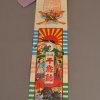 |
Chitose-ame Bag and Omamori |
This omamori (amulet) and paper bag packaging would have been used during the Shichigosan (7-5-3) Festival. (a) shows the packaging for chitose-ame, the "candy of a thousand years" that is given to children by a priest when they visit a Shinto shrine during the Shichigosan... |
AB 84-30 a-b |
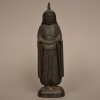 |
Kannon Maria |
This small, carved wooden figurine represents Kannon Maria: the Virgin Mary disguised as the bodhisattva Kannon, known as the Bodhisattva of Compassion. The statue comes from the island of Kyūshū, Japan, where Kakure Kirishitans ("hidden Christians") practiced their faith in secret, in... |
AB 89-4 |
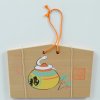 |
Ema |
This small wooden ema (votive plaque) is painted with a white snake wrapped around a yellow, red, and green top next to small plants. The plaque is from 1989, which was the Year of the Snake, thus most ema made during this time would also feature snake designs. The top... |
AB 89-9 |
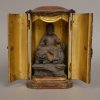 |
Buddhist Shrine |
This miniature religious shrine contains a statue of the Buddha, or possibly of the Bodhisattva Manjusri. The Buddha statue is made of a dark brown, carved wood. He is depicted seated on a lion, which in turn crouches upon a rock. The Buddha is seated in the "demon-subduing" posture, with his... |
AB 979 |
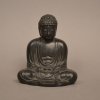 |
Miniature Buddha |
This small sculpture of a Buddha figure is a miniature reproduction of the Great Buddha statue at Kotoku-in temple in Kamakura, Japan, a colossal outdoor bronze sculpture of the Amida (Amitabha) Buddha. The Buddha is seated in a meditative posture, with his legs folded, and his hands folded in... |
AB XX 126 |
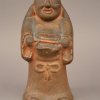 |
Hotei-san |
This figurine represents the Lucky God Hotei, God of Happiness. This Hotei is made of a brown earthenware, and is skinnier than the other eight figures. He holds his characteristic fan in both hands, and a cord securing his robe is tied in a bow in the front. He has large earlobes and an open-... |
TC AB 2014.1.1 |
 |
Hotei-san |
This figurine represents the Lucky God Hotei, God of Happiness. He is one of nine statues of the god that were collected by the original owners of the Japanese House and remains part of the house today. This particular Hotei is made of a brown stone or earthenware, and has the most traditional... |
TC AB 2014.1.4 |
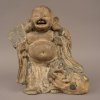 |
Hotei-san |
This figurine represents Hotei, the God of Happiness, one of the Taoist Seven Lucky Gods. This Hotei is depicted with his characteristic large, bare belly, large earlobes, and holding a fan in one hand and a rucksack at his feet. The Hotei may have once been painted, but is now a gray-brown... |
TC AB 2014.1.7 |
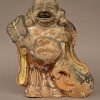 |
Hotei-san |
This figurine represents Hotei, the God of Happiness, one of the Taoist Seven Lucky Gods. This Hotei is depicted with his characteristic large, bare belly, large earlobes, and holding a fan in one hand and a rucksack at his feet. The Hotei may have once been painted, but is now a gray-brown... |
TC AB 2014.1.9 |